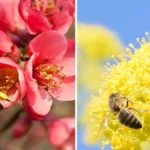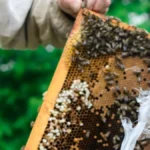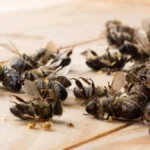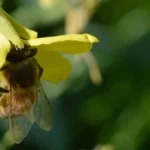Let us have a look at the concept of good bees vs bad bees. When we decide that something is good or bad it is normally a subjective decision. To decide what we consider “good” and “bad” in a bee helps us figure out what a “good” or “bad” bee is.
Let us start this story of good bees vs bad bees with a journey to Mbankana in the Democratic Republic of Congo. Just to get here is a big mission. The Congo is a terrifyingly corrupt, disorganized, chaotic country. To get into the country you have to pay bribes, mind-boggling visa fees, and deal with airport chaos of an epic proportion. And then, the bees in the Congo are regarded by some as being the angriest bees in the world.
I remember my first approach to a hive – everybody got dressed in bee suits. Smokers were at the ready, it was like a military operation. I said, “I don’t need a bee suit”. We walked up to the hive and I used the smoker – a few toots of smoke to the entrance, under the lid, and opened the hive. The bees were more placid than bees I have worked in Canada, many parts of the US, Slovakia, and Japan. These so-called “bad bees” were so peaceful as to be boring.
We moved through the forest to the next hive and it was covered in a layer of bees nearly two inches thick. The entire hive sounded like an air conditioning unit on a hot day. We walked up to these, a few toots of smoke – me with no bee suits and we opened the box, took out honey, and closed it. I didn’t get a single sting. But my skill is I know how to work with bees – if you cannot speak their language, the bees in the Congo will try very hard to, and maybe succeed, in killing you.
On an aside, these bees produced about 200 pounds of honey a year and were stationed in the middle of a weird forest of trees that basically flowered year-round. The rainfall consisted of lunchtime thundershowers and a midnight sprinkle. Every day. Beekeeping paradise.
It appears however that when we talk about “bad bees” we are talking about those mean nasty bees that can stand up for themselves. Let’s unpack these good bees vs bad bees discussion.
Are Angry Bees Bad Bees?
When evaluating good bees vs bad bees you may be inclined to think angry bees are bad bees. Bee anger is a useful trait that bees use to defend themselves against predators. Angry bees can defend themselves against bears and human thieves more than peaceful bees can.
A bear may still be able to get close to an Africanized beehive for example – but the lessons learned will be long and painful. African bees will find the sensitive parts of that bear – and they will sting them. That bear is going to suffer when he next squats in the bushes to take a poop.
If you want to keep bees in your backyard, Angry bees are bad bees. You can measure bee anger very effectively as follows. Buy a pack of materials for dreadlock braiding extensions. This material brings out all the anger bees have in them. Roll it in a little ball. Put it on a string. Hold it a foot away from the entrance of the hive and bounce it around on the string. Measure the number of bees on that ball after thirty seconds. With Africanised bees, you will not be able to count – the ball will be a hissing mass of furious bees. With Carniolans you will probably have to continue bouncing that thing for another hour to get a bee interested.
What’s The Most Aggressive Bee?
This is a difficult question to answer. Some bees get angry fast and just have a mild response, other bees take a long time to get angry but when they do they go completely insane. If I were to rank bees personally in terms of an overall “Angryness” level it would be something like this from most angry to most peaceful:
Apis mellifera scutellata and adansonii are the most volatile bees I have ever worked with. This seems to be backed up by literature. That said, the individual variation from hive to hive and season to season is great. I have worked Scuts and Adonsonis that were the gentlest, most fluffy lovable hives around. These bees have just not had anybody select for peaceful traits in them, and as a consequence, they are mainly bristly angry bees. In the good bees vs bad bees debate, these are the most badass angry bees around. Do not mess with them if you are not ready to get stung a bit.
Apis mellifera mellifera is a pretty crabby little bee if you get it worked up the wrong way. They are relatively calm, but if they get angry they get really angry. They always seem to have a few “face banger” bees that will fly off the frames and hit you in the face. I enjoy these bees, and they are proper characters – but treat them with great respect. They will educate you if you do not. In the good bees vs bad bees debate, these ladies can definitely stand their ground and educate you if you treat them badly.
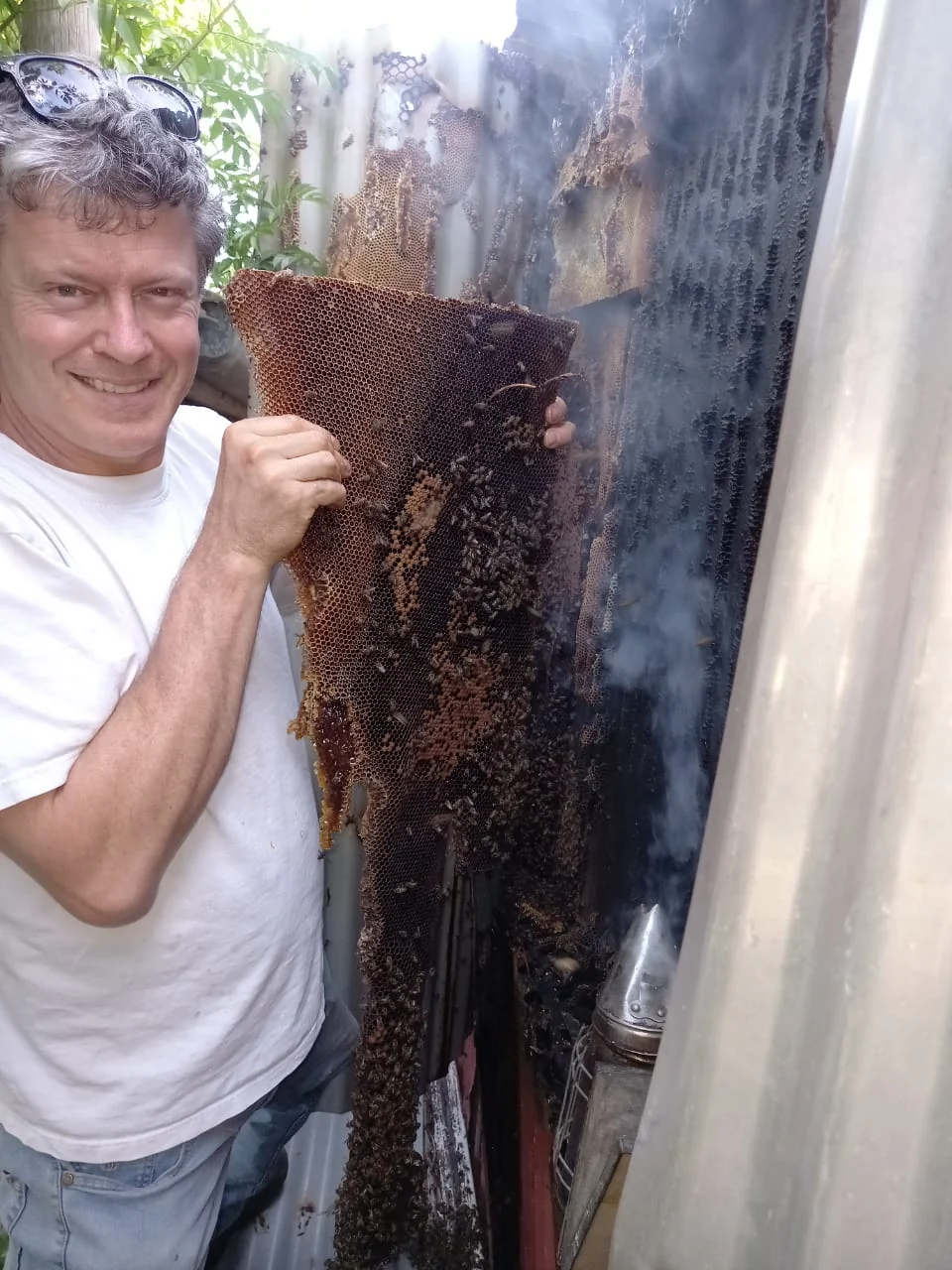
This is me working with some cape honeybees – no bee suit, no stings.
Apis mellifera capensis is the Cape Honeybee – native to the tip of Africa. These are actually my second favorite bees in the whole world. I once had a picnic in the mountains and saw a hive on a cliff – I snuck up to it and pinched a honeycomb – without a smoker and a bee suit. If you move slowly and are gentle they can be remarkably forgiving. These bees are actually just weird on every level. Generally a very calm pleasant bee – but make them angry and they will sting until not a bee is left alive. But you really have to try hard to make them angry. In the good bees vs bad bees debate the Cape honeybee is the outlier – it is neither – it is just weird. It is the bee that pitches up to play football wearing ice skates.Â
Apis mellifera carnica. These bees in central Europe are supposedly very peaceful and easy to work with. I have been chased out of sunflower and canola fields before I even got within 30 feet of the apiary by these bees. I am not sure if that was due to pesticide damage, but I found these bees to be really crabby and unpleasant. I have worked so-called “carnica” in Canada and these were peaceful – but more bred for purpose bee. Hence if the Canadian carnica were what normal carnica are like, and the Slovakian ones were poisoned, then carnica are peaceful. I am suspicious!! On the good bees vs bad bees debate, I reckon Carnica are pretty badass and can look after themselves if they need to.
Apis mellifera whatever is in Lesotho. I think they are still arguing about what the bee in the Lesotho highlands is. But this bee is so gentle compared to the lowland bees that it is just incredible. Big gentle dopey bees that just buzz high up in the mountain air visiting the mountain flowers. There was a theory that these bees may be Apis mellifera monticola. Friends of mine have worked with Monticola in Kenya and agree that this is a very peaceful bee.
Apis mellifera ligustica and Buckfast bees – these are gentle gentle bees. Buckfast bees can get crabby if badly bred, but generally, these are the second most gentle group of bees I have ever worked with. In terms of the general good bees vs bad bees question, these are about as good as it gets. They are nice to work with, make a lot of honey and are forgiving.
Apis mellifera unicolor – this is a very weird bee found in Madagascar, the Mascarene Islands, and a little bit of Africa. It is a very very weird very placid bee. I have worked hives of these bees without a bee suit and without a smoker. Maybe I was just lucky, but they were in my experience the calmest most placid, almost pathetic bees I have ever encountered.
What Types Of Bees Are Dangerous?
Angry bees are dangerous. Don’t make bees angry! Depending on the characteristics of the bees in your area, adapt your behavior to avoid making them angry. If your bees are peaceful dopy Italian bees you can take a few more chances than if you have Africanized bees. Bees are ladies, and as with all ladies, being respectful and not pushing their buttons will give you sweetness and love – pushing their buttons and incurring anger will result in punishment. The amount of that punishment varies from hive to hive, but all bees are dangerous. In the good bees vs bad bees debate, any bee pushed enough can become a bit bad!
How Can You Tell A Good Bee?
Bees have personalities that are a factor of their genetics, their location, the types of flowers being pollinated, temperature, humidity, wind, rain, etc. If a hive starts stinging you before you can get smoke to it, that is an angry hive. If it always does this, then let us say that that hive has a high risk of causing trouble. If lots of stings are a bad thing, then a hive that stings a lot is not a good beehive. Requeen it.
For me, a beehive I keep in town in my garden needs to be gentle. I make a judgment here on good vs bad bees. I will remove angry bees. A beehive that I keep in an apiary in the wilds needs to be angry. Angry bees educate predators and other pests that you find in the wild like little boys. Little boys and air rifles often get mixed up with beehives. Angry bees help to educate these creatures.
Hence in the good bees vs bad bees debate, town bees are good if they are gentle, and out in the country bees are good if they can defend themselves.
I hope this article has helped you see that deciding which are good bees vs bad bees is really a case-by-case choice. Good bees for one job may be bad bees for another. But the most important lesson is that ALL bees are good bees. They pollinate flowers, and without flowers being pollinated our world is a dull boring place. Share if you enjoyed the read.
Aggressive Bees FAQs
What Does It Mean to Have Good Bees vs Bad Bees?
“Good” and “bad” bees are subjective terms used by beekeepers to describe bee behavior. Good bees tend to be more docile and manageable, while bad bees may be more aggressive and harder to work with.
Are Aggressive Bees Considered Bad Bees?
Not necessarily. Aggressive bees often excel at defending their hives from predators, but they may not be suitable for beekeepers in urban or suburban areas where frequent interaction is required.
Which Bee Species Are Considered More Aggressive?
Africanized bees, including Apis mellifera scutellata and adansonii, are known to be highly defensive. However, even within these species, some colonies may be calmer than others, depending on environmental factors and genetics.
Are Aggressive Bees Better for Honey Production?
Aggressive bees can produce large amounts of honey because they tend to be more active foragers. However, their temper may make hive management more challenging, which can hinder productivity in some cases.
How Can I Tell If My Bees Are Aggressive?
You can test bee aggression by using a smoker or a soft object near the hive to see how quickly and intensely the bees react. Aggressive bees tend to swarm and sting more quickly than calmer species like Italian bees.
Can Aggressive Bees Be Calmed Down?
While bees have natural tendencies toward aggression, proper hive management and the use of tools like smokers can reduce their defensive behavior. Requeening the hive with a more docile queen can also help manage aggression.
What Makes a Bee Good for Urban Beekeeping?
Bees that are gentle, like Apis mellifera ligustica (Italian bees) or Buckfast bees, are ideal for urban settings where human interaction is frequent. These bees are less likely to sting and are easier to work with.
Are Aggressive Bees More Dangerous?
Yes, aggressive bees can be dangerous, especially in areas where people or pets are present. Africanized bees, for example, are known for their quick and intense defensive swarming behavior, which can result in multiple stings.
Why Are Some Bee Species More Aggressive Than Others?
Bee aggression can be linked to environmental pressures and survival strategies. Bees in areas with more predators or harsher climates tend to develop more defensive behaviors to protect their hives and resources.
Can I Keep Aggressive Bees If I’m a Beginner Beekeeper?
It’s not recommended for beginners to start with aggressive bees like Africanized or Apis mellifera mellifera. Starting with more docile species like Italian or Carniolan bees will allow you to learn beekeeping techniques in a safer, more manageable environment.

Dr. Garth A. Cambray is a Canadian/South African entrepreneur and beekeeper with 28 years of experience in apiculture and specializes in adding value to honey. His Ph.D. research developed a new advanced continuous fermentation method for making mead that has resulted in a number of companies globally being able to access markets for mead. His company, Makana Meadery, exports honey mead to the USA where it is available to discerning connoisseurs. He has also developed technologies to commercially manufacture organic honey vinegar in Zambia for export globally. He holds a few patents globally in the ethanol industry and believes in technology and knowledge transfer for human development and environmental sustainability. One of his proudest achievements is the fact that the wind farm he started at one of his old apiary sites has essentially made his hometown carbon neutral.

